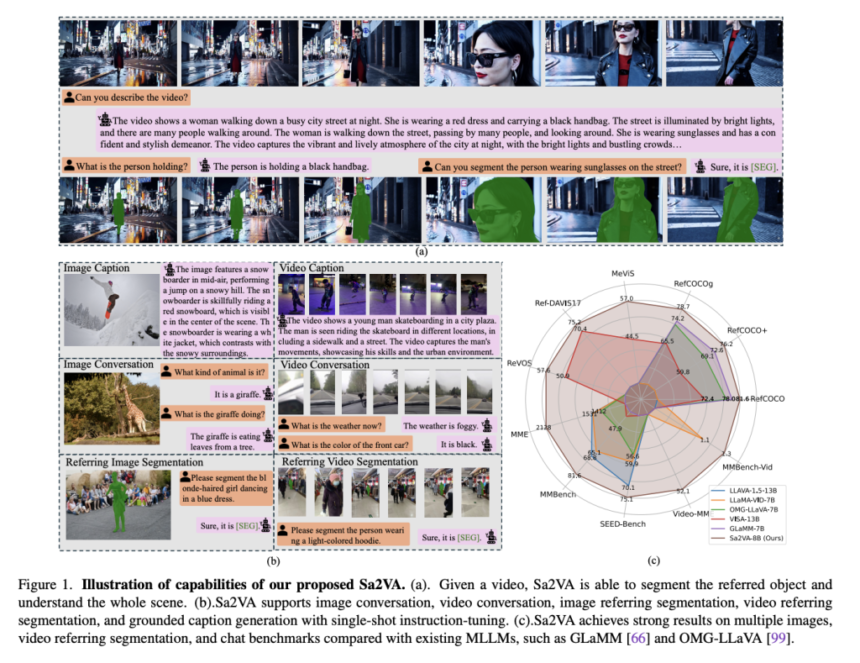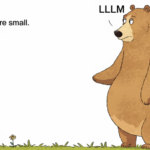

Multi-modal Large Language Models (MLLMs) have revolutionized various image and video-related tasks, including visual question answering, narrative generation, and interactive editing. A critical challenge in this field is achieving fine-grained video content understanding, which involves pixel-level segmentation, tracking with language descriptions, and performing visual question answering on specific video prompts. While state-of-the-art video perception models excel at tasks like segmentation and tracking, they lack open-ended language understanding and conversation capabilities. Moreover, video MLLMs demonstrate strong performance in video comprehension, and question answering but fall short in handling perception tasks and visual prompts.
Existing attempts to address video understanding challenges have followed two main approaches: MLLMs and Referring Segmentation systems. MLLMs initially focused on developing improved multi-modal fusion methods and feature extractors, eventually evolving towards instruction tuning on LLMs with frameworks like LLaVA. Recent developments have attempted to unify image, video, and multi-image analysis in single frameworks, such as LLaVA-OneVision. In parallel, Referring Segmentation systems have progressed from basic fusion modules to transformer-based methods, that integrate segmentation and tracking inside videos. However, these solutions lack comprehensive integration of perception and language understanding capabilities.
Researchers from UC Merced, Bytedance Seed, Wuhan University, and Peking University have proposed Sa2VA, a groundbreaking unified model designed for a dense grounded understanding of images and videos. The model differentiates itself by supporting a comprehensive range of image and video tasks through minimal one-shot instruction tuning, overcoming the limitations of existing multi-modal large language models. Sa2VA’s innovative approach integrates SAM-2, with LLaVA, unifying text, image, and video into a shared LLM token space. The researchers have also introduced Ref-SAV, an extensive auto-labeled dataset containing over 72K object expressions in complex video scenes, with 2K manually validated video objects to ensure robust benchmarking capabilities.
Sa2VA’s architecture integrates two main components: a LLaVA-like model and SAM-2, connected through a novel decoupled design. The LLaVA-like component consists of a visual encoder processing images and videos, a visual projection layer, and an LLM for text token prediction. The system employs a unique decoupled approach where SAM-2 operates alongside the pre-trained LLaVA model without direct token exchange, maintaining computational efficiency and enabling plug-and-play functionality with various pre-trained MLLMs. The key innovation lies in the connection mechanism using a special “[SEG]” token, allowing SAM-2 to generate segmentation masks while enabling gradient backpropagation through the “[SEG]” token to optimize the MLLM’s prompt generation capabilities.
The Sa2VA model achieves state-of-the-art results on referring segmentation tasks, with Sa2VA-8B scoring 81.6, 76.2, and 78.9 cIoU on RefCOCO, RefCOCO+, and RefCOCOg respectively, outperforming previous systems like GLaMM-7B. In conversational capabilities, Sa2VA shows strong performance with scores of 2128 on MME, 81.6 on MMbench, and 75.1 on SEED-Bench. The model excels in video benchmarks, surpassing previous state-of-the-art VISA-13B by substantial margins on MeVIS, RefDAVIS17, and ReVOS. Moreover, Sa2VA’s performance is noteworthy considering its smaller model size compared to competitors, showing its efficiency and effectiveness across both image and video understanding tasks.
In this paper, researchers introduced Sa2VA which represents a significant advancement in multi-modal understanding by successfully integrating SAM-2’s video segmentation capabilities with LLaVA’s language processing abilities. The framework’s versatility is shown through its ability to handle diverse image and video understanding tasks with minimal one-shot instruction tuning, addressing the long-standing challenge of combining perception and language understanding. Sa2VA’s strong performance across multiple benchmarks, from referring segmentation to conversational tasks, validates its effectiveness as a unified solution for a dense, grounded understanding of visual content marking a significant step forward in the multi-modal AI systems field.
Check out the Paper and Model on Hugging Face. All credit for this research goes to the researchers of this project. Also, don’t forget to follow us on Twitter and join our Telegram Channel and LinkedIn Group. Don’t Forget to join our 65k+ ML SubReddit.
 FREE UPCOMING AI WEBINAR (JAN 15, 2025): Boost LLM Accuracy with Synthetic Data and Evaluation Intelligence–Join this webinar to gain actionable insights into boosting LLM model performance and accuracy while safeguarding data privacy.
FREE UPCOMING AI WEBINAR (JAN 15, 2025): Boost LLM Accuracy with Synthetic Data and Evaluation Intelligence–Join this webinar to gain actionable insights into boosting LLM model performance and accuracy while safeguarding data privacy.
The post Sa2VA: A Unified AI Framework for Dense Grounded Video and Image Understanding through SAM-2 and LLaVA Integration appeared first on MarkTechPost.






